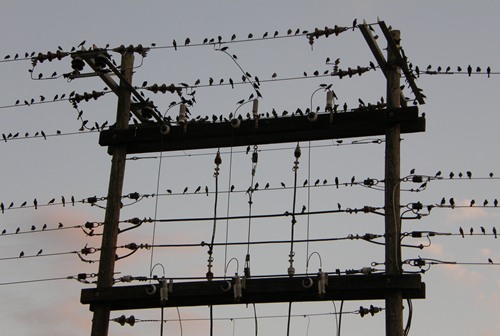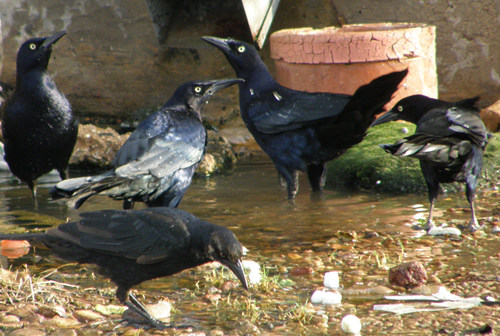|
| If
there's a Texas bird that stirs more debate than the mockingbird
it's got to be the grackle, or Quiscalus mexicanus. Some Texans
of a certain bent believe the grackle should replace the mockingbird
as the state bird of Texas. Others would rather see the grackle become
an endangered species or, better yet, extinct. |
 |
The grackle haters
start with the name - grackle - which rhymes with cackle. The grackle
doesn't cackle but it's not a crooner like the mockingbird. According
to Mexican legend, the grackle's song consists of seven notes representing
the Seven Passions of Life: Love, Hate, Fear, Courage, Joy, Sadness
and Anger. Among Texans, Hate and Anger appear to be leading the pack.
Grackles have been attacked by cannons in Houston, explosives in New
Mexico and lasers in Austin. USA Today has labeled it "the
devil bird."
Most of the grackle hate comes from the birds' habit of roosting in
large groups called "annoyances" or "plagues" (they're really called
that) and then singing - or squawking - and pooping to beat the band.
They show a strong preference for large grocery store parking lots
with trees. Warning: Do not stand under those trees at dusk.
But not everybody hates grackles. Texas Monthly writer John
Nova Lomax for one believes the state bird of Texas should be unique,
not something we share with the likes of Arkansas, Mississippi, Florida,
and Tennessee.
"What's more Texas than a hearty symphony of grackle racket?" he asks
in his ode to the grackle. "These birds can sound like everything
from a squeaky door hinge to explosions of static from a radio left
on at high volume to laughing whistles to monkey-like rattles. On
warm spring mornings, their orchestrated cacophony just sounds like
home. In Texas, they put the 'jungle' in urban jungle."
The great-tailed grackle (one of three species that take wing in Texas)
has flocked to Texas cities in numbers paralleled only by people from
other states doing the same thing. Native and non-native Texans alike
accuse the grackle of being an interloper of the worst kind - an invasive
species. Not so. They're native to the U.S., but they have become
more native - or at least more widespread - than they used to be.
|
 |
The
story goes that an Aztec emperor named Ahuitzotl, a relative of Montezuma,
took his armies to the lowlands east of Mexico City in the 1400s,
conquered the people there and brought back slaves and some big black
birds with long, black iridescent feathers. Grackles. The Aztecs loved
feathers, and these feathers were black, like those of the blackbird,
but splashed with ocean blues and royal purples. The Aztecs actually
bred grackles, and woe be unto those who ruffled even a single one
of those beautiful feathers. Ornithologists point to this as possibly
the first time humans intentionally relocated wild animals in the
new word while also showing us that grackles have been gathering in
cities for more than 500 years.
Over the intervening centuries and especially in the last decades,
the grackles have made serious inroads into Texas. According to J.K.
Strecker's pioneering work on Texas birds, The Birds of Texas,
grackles were limited to South Texas in 1912. H.C. Oberholser's 1974
Bird Life of Texas has them showing up in Fort
Worth in 1944 and Dallas
three years later.
Grackles have now migrated to 22 other states, gathering in annoyances
as far north as Montana and as far west as Washington. According to
bird biologist Alan Clark, grackles are increasing their range at
about four percent a year even as overall populations decline.
"They're an unstoppable machine," Clark told USA Today in 2013.
"They're really hard to scare, they're hard to kill and they're in
such huge groups that even poison isn't particularly effective."
Poison? Isn't it illegal to kill grackles or any other bird under
the federal Migratory Bird Treaty Act? Not really. The United States
Department of Agriculture makes an exception for grackles that allows
for them to be harassed and removed without permits. Yes, removed.
Mike Bodenchuck, director of the United States Department of Agriculture
(USDA) Wildlife Services in San
Antonio says that a standing order allows people to get rid of
grackles if they're harming crops, damaging plants, affecting human
health and safety or if they're simply making a nuisance of themselves.
"If you've got a tree outside your bedroom window and they're keeping
you awake, you can go out and kill them if it's okay in your area,"
Bodenchuk told USA Today. "The problem is that killing them
doesn't do much. If you kill 10, 10 more will show up."
Killing grackles would be more problematic for loyal and discerning
Texans if they happened to be the state bird. We don't kill mockingbirds,
not only because To Kill a Mockingbird tells us it's a sin
to do so but because it's illegal and because shooting a mockingbird
would just be wrong.
Though grackles aren't celebrated in song and literature to the same
extent as the mockingbird they have their literary backers. William
Penn Warren wrote a poem called "Grackles Go" as an observation of
their migratory nature, not as a plea.
Still, the grackle isn't going to replace the mockingbird
as the state bird of Texas any time soon. With people from other parts
of the country expanding their range in Texas at about the same four
percent rate as the grackles, and given these people's reaction to
the grackles, the mockingbird's official status is probably safe for
the foreseeable future. |
|
\
|
